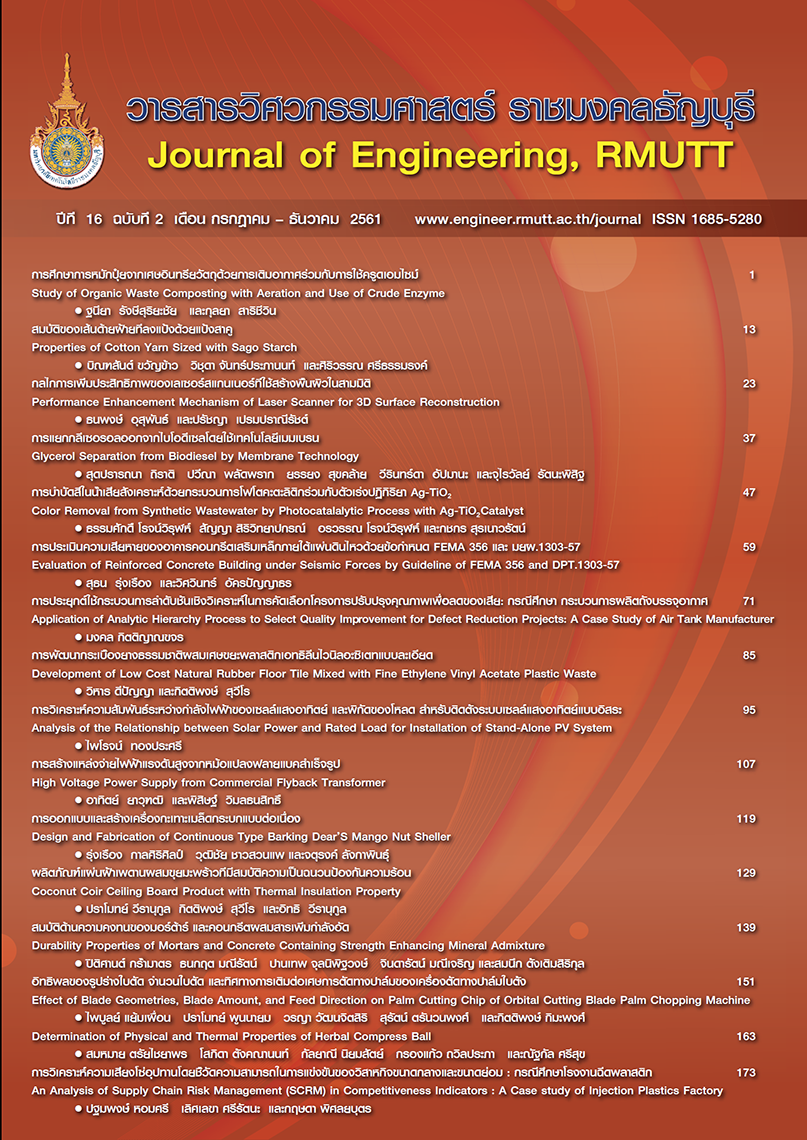Coconut Coir Ceiling Board Product with Thermal Insulation Property
Main Article Content
Abstract
งานวิจัยนี้มีวัตถุประสงค์เพื่อพัฒนาแผ่นฝ้าเพดานผสมขุยมะพร้าว โดยออกแบบอัตราส่วนยิปซัมปลาสเตอร์: ขุยมะพร้าว: โซเดียมซิลิเกต: น้ำประปา จำนวน 5 อัตราส่วน ได้แก่ 1: 0: 1: 0.03, 1: 100: 1: 0.03, 1: 150: 1: 0.03, 1: 200: 1: 0.03, 1: 250: 1: 0.03 และ 1: 300: 1: 0.03 โดยน้ำหนัก ขึ้นรูปแผ่นฝ้าเพดานด้วยวิธีหล่อในอุณหภูมิปกติ (30 – 35 องศาเซลเซียส) ทำการทดสอบสมบัติตามมาตรฐาน มอก.219-2552 เรื่องแผ่นยิปซัม ประกอบด้วย การทดสอบแรงกดแตก แรงต้านทานการดึงตะปู การแอ่นตัว การดูดซึมน้ำ ความหนาแน่น และสัมประสิทธิ์การนำความร้อน ผลการทดสอบ พบว่า อัตราส่วน 1: 150: 1: 0.03 โดยน้ำหนัก เป็นอัตราส่วนแผ่นฝ้าเพดานผสมขุยมะพร้าวเหมาะสมที่สุด แผ่นซีเมนต์บอร์ดที่พัฒนาขึ้นนี้ สามารถลดปริมาณขุยกะลามะพร้าวเหลือทิ้ง และได้ผลิตภัณฑ์แผ่นฝ้าเพดานที่มีสมบัติความเป็นฉนวนป้องกันความร้อนที่ดี
Article Details
The manuscript, information, content, picture and so forth which were published on Frontiers in engineering innovation research has been a copyright of this journal only. There is not allow anyone or any organize to duplicate all content or some document for unethical publication.
References
Office of the Higher Education Commission. Development of Light-weight Materials from Coconut Fiber, Project of Research and Technology Transfer of Coconut. Bangkok: Research Network in Lower Central of Thailand, Office of the Higher Education Commission; 2004. (in Thai)
Asasutjarit, C., Hirunlabh, J., Khedari, J., Charoenvai, S., Zeghmati, B., & Shin, U. C.. Development of coconut coir-based lightweight cement board. Construction and Building Materials. 2007; 21(2): 277–288.
Prachoom Khamput, Somkiat Rungthongbaisuree, Sompit Deeboonno, and Suroj Srisinhorm. Development of Cement Roof Tile and Ceiling Board by Using Natural Rubber for Reducing the Indoor Temperature. Pathum Thani: Rajamangala University of Technology Thanyaburi; 2009. (in Thai)
Kasikorn Research Center. Real Estate Trend. [Internet]. 2012 [cited 2012 Sep 4]. Available from : https://www.kasikorn research.com/th/k-econanalysis/pages/ ViewSummary.aspx?docid=31781 (in Thai)
Thai Industrial Standards Institute (TISI). Thai Industrial Standard No.219-2009: Gypsum Board. Bangkok: Thai Industrial Standards Institute; 2009. (in Thai)
American Society for Testing and Materials (ASTM). Annual Book of ASTM Standards. Philadelphia: American Society for Testing and Materials; 2012.
Parinya Jindaprasert and Chai Jaturapitakkul. Cement, Pozzolan, and Concrete. 7th ed. Bangkok: ACI Partners with Thailand Concrete Association; 2012. (in Thai)
Bledzki, A.K. and Gassan, J.. Composites Reinforced with Cellulose based Fibers. Progress in Polymer Science. 1999; 24: 221-274.
Faherty, Keith F. and Williamson, Thomas G.. Wood Engineering and Construction Handbook. 2nd ed. New York: McGraw-Hill, Inc.; 1995.
Tanunchai Pakunworakij, Pantuda Puthipiroj, Woratham Oonjittichai and Panjira Tisavipat. Thermal resistance efficiency of building insulation material fromagricultural waste. Journal of Architectural/Planning Research and Studies. 2006; 3(4): 119-126. (in Thai)


